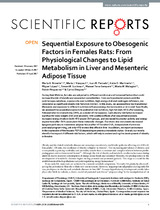Mostrar el registro sencillo del ítem
Sequential Exposure to Obesogenic Factors in Females Rats: From Physiological Changes to Lipid Metabolism in Liver and Mesenteric Adipose Tissue
| dc.contributor.author | Novelle, Marta G. | |
| dc.contributor.author | Vázquez, María J. | |
| dc.contributor.author | Peinado, Juan R. | |
| dc.contributor.author | Martinello, Kátia D. | |
| dc.contributor.author | López, Miguel | |
| dc.contributor.author | Luckman, Simon M. | |
| dc.contributor.author | Tena-Sempere, Manuel | |
| dc.contributor.author | Malagón, María M. | |
| dc.contributor.author | Nogueiras, Rubén | |
| dc.contributor.author | Diéguez, Carlos | |
| dc.date.accessioned | 2020-04-02T19:40:50Z | |
| dc.date.available | 2020-04-02T19:40:50Z | |
| dc.date.issued | 2017 | |
| dc.identifier.uri | http://hdl.handle.net/10396/19870 | |
| dc.description.abstract | During their lifetime, females are subjected to different nutritional and hormonal factors that could increase the risk of obesity and associated comorbidities. From early postnatal periods until the postmenopausal phase, exposure to over nutrition, high-energy diet and oestrogen deficiency, are considered as significant obesity risk factors in women. In this study, we assessed how key transitional life events and exposure to different nutrition influence energy homeostasis in a rat model. Specifically, we assessed the sequential exposure to postnatal over nutrition, high-fat diet (HFD) after weaning, followed later by ovariectomy (OVX; as a model of menopause). Each obesity risk factor increased significantly body weight (BW) and adiposity, with additive effects after sequential exposure. Increased energy intake in both HFD and/or OVX groups, and decreased locomotor activity and energy expenditure after OVX can explain these metabolic changes. Our study also documents decreased lipogenic pathway in mesenteric adipose tissue after HFD and/or OVX, independent of previous postnatal programming, yet only HFD evoked this effect in liver. In addition, we report an increase in the expression of the hepatic PEPCK depending on previous metabolic status. Overall, our results identify the impact of different risk factors, which will help in understanding the development of obesity in females. | es_ES |
| dc.format.mimetype | application/pdf | es_ES |
| dc.language.iso | eng | es_ES |
| dc.publisher | Nature Research | es_ES |
| dc.rights | https://creativecommons.org/licenses/by-nc-nd/4.0/ | es_ES |
| dc.source | Scientific Reports 7, 46194 (2017) | es_ES |
| dc.subject | Fat metabolism | es_ES |
| dc.subject | Metabolic diseases | es_ES |
| dc.subject | Obesity | es_ES |
| dc.subject | Energy homeostasis | es_ES |
| dc.subject | High-fat diet | es_ES |
| dc.subject | Ovariectomy | es_ES |
| dc.title | Sequential Exposure to Obesogenic Factors in Females Rats: From Physiological Changes to Lipid Metabolism in Liver and Mesenteric Adipose Tissue | es_ES |
| dc.type | info:eu-repo/semantics/article | es_ES |
| dc.relation.publisherversion | https://doi.org/10.1038/srep46194 | es_ES |
| dc.relation.projectID | info:eu-repo/grantAgreement/EC/FP7/281854 (ObERStress) | es_ES |
| dc.relation.projectID | info:eu-repo/grantAgreement/EC/FP7/281408 (OBESITY53) | es_ES |
| dc.relation.projectID | Gobierno de España. SAF2015-71026-R | es_ES |
| dc.relation.projectID | Gobierno de España. BFU2015-70454-REDT | es_ES |
| dc.relation.projectID | Gobierno de España. BFU2015 | es_ES |
| dc.relation.projectID | Gobierno de España. BFU2014-55871 | es_ES |
| dc.relation.projectID | Instituto de Salud Carlos III. PT13/0001 | es_ES |
| dc.rights.accessRights | info:eu-repo/semantics/openAccess | es_ES |

